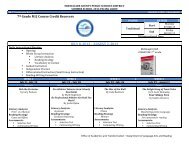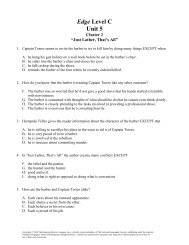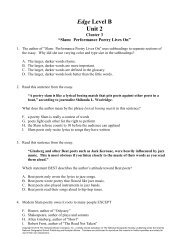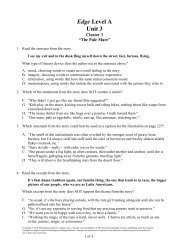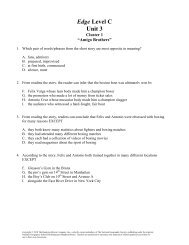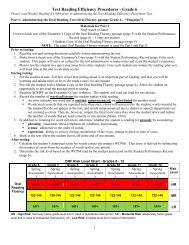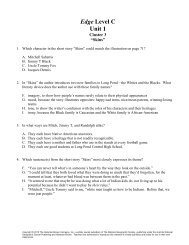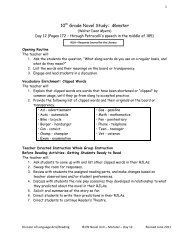Touching Spirit Bear - Division of Language Arts/Reading
Touching Spirit Bear - Division of Language Arts/Reading
Touching Spirit Bear - Division of Language Arts/Reading
- No tags were found...
You also want an ePaper? Increase the reach of your titles
YUMPU automatically turns print PDFs into web optimized ePapers that Google loves.
3Dance TherapyWhat Is It? How Does It Work? What You Can Expect Health Benefits How To Choose a PractitionerCautionsWhat Is It?Dance therapy (also called dance/movement therapy) is the use <strong>of</strong> choreographed or improvisedmovement as a way <strong>of</strong> treating social, emotional, cognitive, and physical problems. Throughout theages, people <strong>of</strong> many cultures have used dance to express powerful emotions, tell stories, treat illness,celebrate important events, and maintain communal bonds. Dance therapy harnesses this power <strong>of</strong>movement in a therapeutic setting and uses it to promote personal growth, health, and well-being.Dance as therapy came into existence as a marriage <strong>of</strong> sorts between modern dance and psychiatry. Itwas pioneered by Marian Chase (1896-1970), who studied dance in New York City before establishingher own studio in Washington, DC, in the 1930s. Because Chase's dance classes provided uniqueopportunities for self-expression, communication, and group interaction, psychiatrists in Washingtonbegan sending patients to her.By the mid-1940s Chase was giving lectures and demonstrations, and other pr<strong>of</strong>essional dancers soonfollowed her lead, using dance to help people with an array <strong>of</strong> emotional, mental, and physicalproblems. It was not until 1966, when the American Dance Therapy Association (ADTA) was founded,that dance therapy gained pr<strong>of</strong>essional recognition. Today the ADTA has nearly 1,200 members in 46states and 20 countries around the world.How Does It Work?Dance therapy is based on the premise that the body and mind are interrelated. Dance therapistsbelieve that mental and emotional problems are <strong>of</strong>ten held in the body in the form <strong>of</strong> muscle tension andconstrained movement patterns. Conversely, they believe that the state <strong>of</strong> the body can affect attitudeand feelings, both positively and negatively.Dance movements promote healing in a number <strong>of</strong> ways. Moving as a group brings people out <strong>of</strong>isolation, creates powerful social and emotional bonds, and generates the good feelings that comefrom being with others. Moving rhythmically eases muscular rigidity, diminishes anxiety, and increasesenergy. Moving spontaneously helps people learn to recognize and trust their impulses, and to act onor contain them as they choose. Moving creatively encourages self-expression and opens up new ways<strong>of</strong> thinking and doing.On a purely physical level, dance therapy provides the benefits <strong>of</strong> exercise: improved health, wellbeing,coordination, and muscle tone. On an emotional level, it helps people feel more joyful and confident,and allows them to explore such issues as anger, frustration, and loss that may be too difficult to exploreverbally. On a mental level, dance therapy seeks to enhance cognitive skills, motivation, and memory.Dance therapists can also address specific problems in specific ways. For example, to help apatient reduce stress, a dance therapist would first identify how the person's body reacts to stress,then explore specific movement techniques to increase circulation, deepen breathing, and reducemuscle tension.What You Can Expect?Your dance therapy experience will depend on your ailment, whether you work with a dance therapistin private practice or in the context <strong>of</strong> a treatment team, and whether you are the only patient or part <strong>of</strong>a group. And naturally different dance therapists have different styles. You need absolutely no previousdance training to benefit from dance therapy.Generally speaking, however, for the initial consultation, you will meet with the dance therapist in adance studio. You should wear comfortable clothing for this and all subsequent sessions. First, thetherapist will talk with you about your needs and your reasons for wanting treatment. Next, the therapistmay ask you to walk around the studio in order to analyze your body shape, posture, and movements: Isyour body erect or caved in? Do you reach out or hold yourself in? Do you move in a fluid or restrictedway? Finally, the dance therapist will discuss your treatment goals with you, and the two <strong>of</strong> you mightarrive at an agreement regarding the duration and nature <strong>of</strong> the therapy. You should review your goalswith the therapist periodically to see if you are meeting them.<strong>Division</strong> <strong>of</strong> <strong>Language</strong> <strong>Arts</strong>/<strong>Reading</strong> IR-EN Novel Unit – <strong>Spirit</strong> <strong>Bear</strong> – Day 15 Revised June 2011



